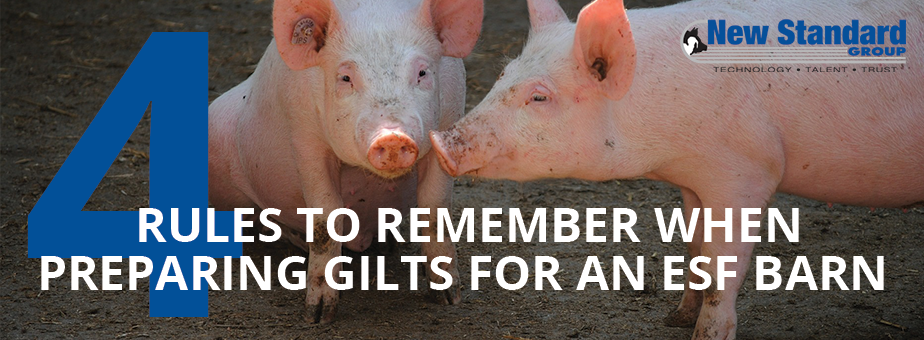
The success of your ESF barn, upon startup and during regular operation, depends on a few key factors. One of the most important of these is how you train the gilts that are coming into the system, and more specifically, how you prepare the gilts overall. In this article, we will walk you through the process of preparing, training and acclimating gilts, from weaning through training and further on into breeding. Depending on the flow of animals into your loose sow housing facility, you can incorporate the following four rules at any point in the life of the gilt.
1. Get to Know Your Animals
To most it seems like a waste of time, but spending time getting to know the girls can pay dividends down the road when you’re asking them to trust you when entering the feed station for the first time. Pigs are social animals, which you can learn more about by clicking here. This is a real and significant trait that we need to recognize and use to our advantage. The sooner your staff starts interacting with the animals, the easier the transition to the group sow housing barn will be. If someone in the loose sow housing barn is given the task to simply spend time with the developing gilts for a short period each day, you will find that they will be much easier to work with. A good way to approach this is to have a barn staff member attempt to make some of the girls his or her pets each day.
2. Let Curiosity Lead the Way
Along with these highly social traits, another of the gilts’ traits that should be used to its fullest effect is their natural curiosity. When a pig enters a pen for the first time, she will nose around and will map out the pen for her needs. There are three main areas in a pen for the pig. First, the pig will seek out the area that they can get food and second she’ll determine the area where she will lay and rest in. Once she has determined what those areas look like, the area that is left over (typically the least comfortable area) will be used for dunging. Social and recreational areas are interspersed within the three areas, although these areas tend to not be as well defined and occur in any area where the pigs can mingle.
We recommend allowing the gilts to freely explore the GDU pens for the first time without being forced into any certain area. When exploring a pen to determine where the three main areas are going to be, the gilts will usually look for feed and water first. We can use this searching and exploring to begin to get them comfortable with equipment in general even when they are fairly young.
3. Carrots, Not Sticks
A key hire for your group sow housing barn is the person who works with the gilts while they are developing and especially during the ESF training process. Working with sows and gilts can be quite rewarding if a person enjoys interacting with and caring for animals, and this exactly the kind of person you need in a training position. You need someone who is going to treat the animals like his or her pets. This person will train the girls by comforting and rewarding them for positive actions rather than punishing them for negative actions.
During training, the gilts are asked to learn a lot of new things: where and how to eat, how to use a pen layout that is designed for social group development and how to be in charge of their eating times and patterns. At times, this can be frustrating for the pigs as well as the barn staff working with them. A person with the right attitude will keep their stress levels low, which in turn keeps the stress levels low among the girls they are working with. In this area of a barn, it is vitally important that the training procedures for the gilts be imparted in a gentle fashion and not forced upon the animals. This approach will lead to better demeanors and better habits in the animals and the staff.
4. Promote Good Habits
Once a gilt has been trained to use the ESF feed station, the next step is to have her embed what she has learned and promote good use of the large pens. It will take approximately 5 - 7 days to teach gilts how to use the stations by themselves, but it takes 2 - 3 weeks to foster proper use of the pens. When they enter the pen for the first time, they have come from a pen that didn’t really develop much in the way of social structure. This is the time to promote that. The training pen(s) should be set up as much as possible like a regular ESF pen. The pen should have nesting areas sized for a regular social group of gilts and have the traffic patterns, watering areas and (if incorporated) a heat detection unit all placed similarly to what they will encounter once they graduate to a bred gilt pen.
It is in the second and third week of training that the gilts learn that they are in control of their own feed schedule and can access the feed stations and receive feed without help. They learn to separate themselves into groups, and they start to establish defined areas of the pen for different uses (feeding, lying and dunging). It takes a couple of weeks for these things to be defined and embedded as quality habits that the girl will retain throughout her time in the barn.
In summation, here are the keys to a successful integration of new gilts into an ESF system:
- Interact with the animals as soon as possible to get them used to people
- Set up development pens early to let the curiosity of the gilts make them comfortable in the pen and going through smaller gates
- Understand the different areas within a pen and design to accommodate them
- Place the right people in the gilt development and training area
- Give the training gilts time to develop habits and become efficient in the system





